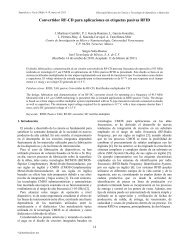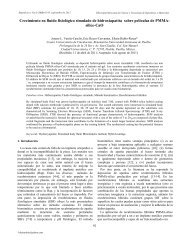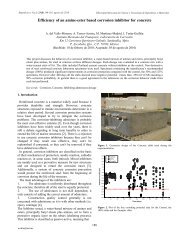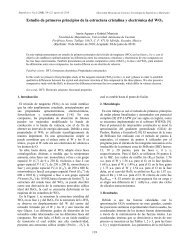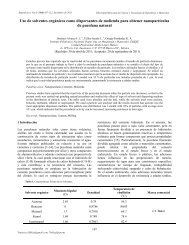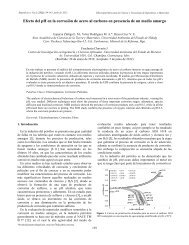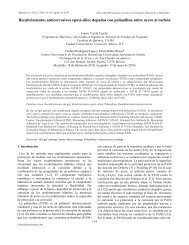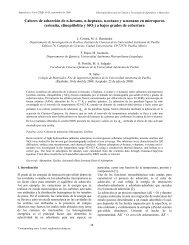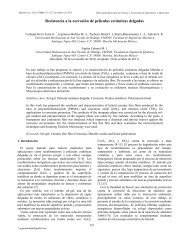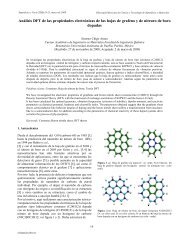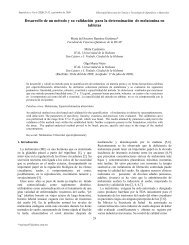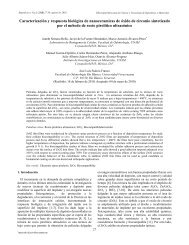Synthesis and characterization of diethyl-p-vinylbenzyl phosphonate ...
Synthesis and characterization of diethyl-p-vinylbenzyl phosphonate ...
Synthesis and characterization of diethyl-p-vinylbenzyl phosphonate ...
Create successful ePaper yourself
Turn your PDF publications into a flip-book with our unique Google optimized e-Paper software.
Superficies y Vacío 22(3) 6-10,septiembre de 2009©Sociedad Mexicana de Ciencia y Tecnología de Superficies y Materiales136.35 ppm corresponding to the C atoms <strong>of</strong> the vinylgroup; the signals at 16.02 <strong>and</strong> 63.69 ppm due to the Catoms on the CH 3 <strong>and</strong> CH 2 <strong>of</strong> the <strong>diethyl</strong>-<strong>phosphonate</strong>group, respectively.Formation <strong>of</strong> the DEpVBP is also evident from their FTIR<strong>and</strong> Raman spectra (see Fig. 3 <strong>and</strong> Fig. 4). IR spectrumrevealed strong absorption b<strong>and</strong>s due to the P=O stretchingvibration mode at 1266 cm -1 , P-O-Et stretching at 1099-1020 cm -1 , P-O-C stretching at 989 cm -1 , all correspondingto the –PO(CH 2 CH 3 ) group; C=C stretching vibration modeat 1630 cm -1 <strong>of</strong> vinyl group; <strong>and</strong> C=C stretching at 1608cm -1 <strong>of</strong> phenyl group. These assignments were based onliterature vibrational studies <strong>of</strong> organic <strong>and</strong> <strong>phosphonate</strong>materials [14-17]. On the other side, in the Ramanspectrum the signals corresponding to the C=C stretchingmodes <strong>of</strong> the vinyl <strong>and</strong> phenyl groups appeared at 1630 cm -1 <strong>and</strong> 1607 cm -1 , respectively.3.2. Polymer <strong>characterization</strong>The poly(DEpVBP) homopolymer was found to besoluble in several polar solvents like ethanol, methanol,DMF, <strong>and</strong> DMSO; but insoluble in toluene, ciclohexane,<strong>and</strong> water. Formation <strong>of</strong> the homopolymer was followed byRaman <strong>and</strong> IR spectroscopies. Fig. 3 <strong>and</strong> Fig. 4 show theIR (4000-400 cm -1 ) <strong>and</strong> Raman (in the spectral range <strong>of</strong>3500-500 cm -1 ) <strong>of</strong> the monomer <strong>and</strong> polymer, indicatingthe region correspond to the C=C stretch. Is clear fromRaman spectra that the principal evidence <strong>of</strong> polymerformation came from the disappearance <strong>of</strong> the signal due toC=C stretching vibration mode <strong>of</strong> vinyl group <strong>of</strong> themonomer. In the IR spectrum <strong>of</strong> the polymer (Figure 3)also the absorption b<strong>and</strong> due to C=C stretching <strong>of</strong> the vinylgroup is absent.Thermal stability <strong>of</strong> the poly(DEpVBP) was studiedthrough thermogravimetric measurements realized at aheating rate <strong>of</strong> 10°C/min under nitrogen atmosphere.Figure 5 Termogravimetric curve <strong>of</strong> the polymer showsdistinct regions <strong>of</strong> weight loss with the increase <strong>of</strong>temperature. The first, a gradual weight loss <strong>of</strong> about 3.4 %in the temperature range 120-208 °C was attributed to theevaporation <strong>of</strong> water <strong>and</strong> DMF. In the second region (208-305 °C), about 13.2 % <strong>of</strong> the weight loss was associated tothe partial thermal degradation <strong>of</strong> poly(DEpVBP) due tothe loss <strong>of</strong> the ethyl ester group <strong>of</strong> the <strong>vinylbenzyl</strong>phosphate. Thermal degradation <strong>of</strong> VBP due to the loss <strong>of</strong>ester groups has been reported at 240-250 °C [13].Progressive thermal degradation <strong>of</strong> the polymer observedbetween 305 <strong>and</strong> 500 °C, is probably due to thedegradation <strong>of</strong> the main chain <strong>of</strong> polymer <strong>and</strong> thedegradation <strong>of</strong> P-C bonds <strong>of</strong> the pendant group <strong>of</strong> polymer.These results indicate that the poly(DEpVBP) synthesizedis stable until 208 °C. Above this temperature, thedegradation <strong>of</strong> polymer occurs in several steps, resulting inthe loss <strong>of</strong> about 47 % <strong>of</strong> the weight <strong>of</strong> polymer.4. ConclusionsDEpVBP monomer was synthesized by means <strong>of</strong>Michaelis-Arbusov reaction using CuCl 2 as inhibitor agent<strong>and</strong> chlorebenzene as solvent, with a yield <strong>of</strong> 75%.<strong>Synthesis</strong> process permits to improve the yield on reported(68%). Poly(DEpVBP) synthesized by free radicalspolymerization shows a good thermal stability until 208 ºC.Molecular structures <strong>of</strong> the synthesized compounds wereconfirmed by 1 H NMR, 13 C APT NMR, IR, <strong>and</strong> Ramanspectroscopies. Owing to the ion exchange capacityconferred by the <strong>phosphonate</strong> group <strong>and</strong> the good thermalTable 1. Assignment <strong>of</strong> 1 H-NMR peak positions <strong>of</strong> the DEpVBP monomer.Chemical Shiftδ (ppm)Integration MultiplicityJ H-H(Hz)AssignmentH 7'H CH1.82 2 s --- H 3 1 C H 2 CH 2 21.33 6 t 6.96 H 1 27.39 2 d 8.04 H 55 H7.33 2 d 8.2 H 46.70 1 m --- H 64 H5.76 1 d 7.57 H 7O5.27 1 d 10.98 H 7’P4.11 4 m --- H 2OH 3 C O7CCH 236CH 31H 5H 4s = singlet, d = doublet, t = triplet <strong>and</strong> m = multiplet9



